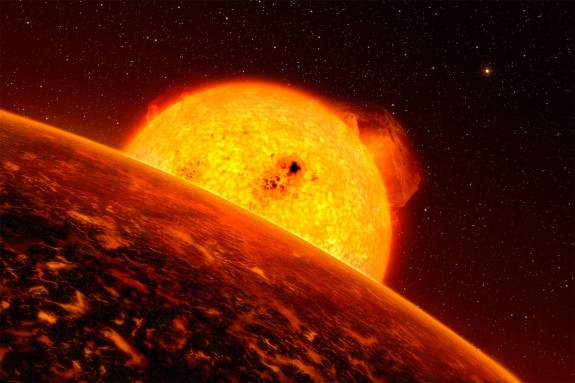You Can’t Throw a Rock in the Milky Way Without Hitting an Earth-Like Planet
A new estimate says there are 17 billion Earth-like planets in the Milky Way

An artist’s impression of the explanet CoRoT-7b. Photo: ESO/ L. Calçada
According to a new estimate, our little corner of the universe—the Milky Way galaxy—is home to a whopping 17 billion Earth-like planets. That is, little rocky orbs about the same size as ours. That works out to around one potential-Earth per every six stars. Who said that space is a lonely place?
As the BBC explains, the high-valued estimate comes as an extrapolation off of the observations of NASA’s planet-hunting Kepler telescope. For actual, rather than estimated, planets, Kepler is now up to 2,740 “planet candidates”—things that scientists think are planets but that need to be double-checked by teams using other means. Of these, 461 were added in a recent announcement. As for confirmed planets discovered by Kepler, we’re up to 105, says Reuters.
Even better news in the search for habitable space, says Adam Mann for Wired, is the estimate that nearly all stars like our own Sun have planets and that half of these systems will have an Earth-like planet:
“If you could randomly travel to a star, it will have planets,” said astronomer Francois Fressin from the Harvard-Smithsonian Center for Astrophysics, during a press conference today here at the American Astronomical Society 2013 meeting.
Among the 2,740 planet candidates so far discovered and the estimated 17 billion Earth-like planets, though, there could be false-positives—planet-looking things that aren’t really planets. According to The Register, around a third of Kepler’s planet candidates could end up being something else.
More from Smithsonian.com:
The 5 Coolest Planets Orbiting Distant Stars
Newly Discovered Earth-like Planet Could be Habitable
What if All 2,299 Exoplanets Orbited One Star?
/https://tf-cmsv2-smithsonianmag-media.s3.amazonaws.com/accounts/headshot/smartnews-colin-schultz-240.jpg)
/https://tf-cmsv2-smithsonianmag-media.s3.amazonaws.com/accounts/headshot/smartnews-colin-schultz-240.jpg)